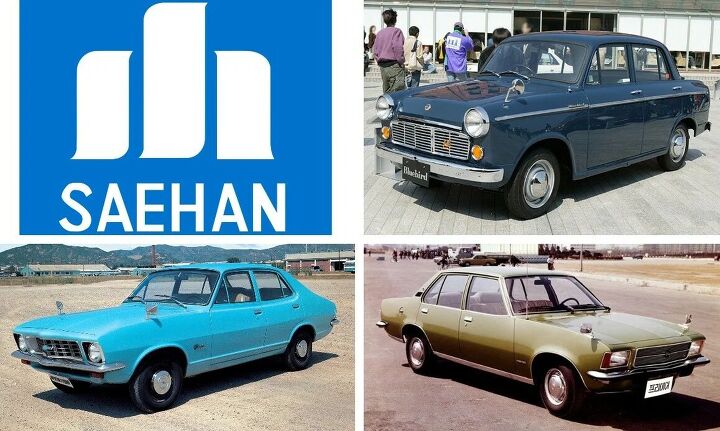


Share
We return to Deserted History’s protection of the twists and turns of the Daewoo story, at a time when the company’s predecessor, Shinjin, was no additional. After an early Seventies joint enterprise with Basic Motors saw the organization renamed to Standard Motors Korea, Shinjin bowed out of the offer after just five a long time. In 1976 Shinjin’s possession in the business was offered to a state-owned Korean lender, and Normal Motors Korea was renamed to Saehan Motor Corporation. But that did not indicate GM was out of the picture – significantly from it.
As we figured out beforehand, the vehicles GM Korea offered had been GM’s various international wares from Europe and Australia, lightly rebadged for Korean current market utilization. The cars ended up not acceptable for Korean people and offered poorly. Behind the scenes, GM didn’t particularly mesh well with Shinjin management.
In truth, it was General Motors who questioned the Korean govt to action in and prepare for a new business husband or wife in the joint venture. Contact was manufactured as a result of the U.S. embassy in Seoul. Shinjin was not well off fiscally in any case, and the Korean governing administration was usually joyful to interfere in private company. The new arrangement with a countrywide bank would definitely be much more hands-off and simplicity the management conflict GM experienced with Shinjin.
With their new stage of control in excess of the working day-to-day operations, GM decided to improve its condition in Korea by changing quite little by little. Continued from the GMK days was the Camina, or as Australians realized it, the Holden Torana. Initially known as the Chevrolet 1700 under GMK distribution, it was frivolously revised and been given a more compact motor in 1976 when it was rebranded to Camina.
Right away right after the title adjust, the Camina grew to become a Saehan Camina. Its smaller 1.5-liter motor was much less thirsty than the Chevrolet 1700, but the car was if not the similar. It is indicated the 1700 no one preferred remained on sale along with the Camina for its remaining three many years on the marketplace. It turned out nobody desired the Camina both, and only 992 illustrations ended up sold in whole amongst GMK and Saehan.
Saehan took the possibility to action more away from the 1700’s failure by rebranding the wagon variant as the Saehan Caravan. Presumably, the larger motor was extra interesting to the more upmarket household wagon section of the sector: Saehan managed to provide 966 Caravans in about a few a long time.
The 1700 and Camina continued on sale by 1978 and fared poorly in opposition to the more Korean-centered competitiveness from the domestic Hyundai and Kia. The Caravan persisted right until early 1979, at which stage GM resolved it was time for a substitution of all a few versions. In general, there was not substantially of a attract for the Korean consumer to order a domestically-manufactured car that was a leftover from what GM provided in other nations.
Saehan experimented with once again in 1977 with its to start with new products considering that GMK’s launch in 1972. Known as the Saehan Gemini, it was a gentle rework of the European current market choose on the Isuzu Gemini that debuted in 1974. The Gemini was an exciting product deserving of its possess Scarce Rides Icons protection. Rear-drive and subcompact, the Gemini was primarily based on the GM T-physique platform. The T was GM’s initially try at a unibody subcompact to be bought in most entire world marketplaces, and you’d know it as the system underneath the Chevette.
Just after its first few a long time, the Gemini stood as the only inexpensive passenger motor vehicle provided by Saehan. It was constructed in two-door coupe and four-doorway sedan formats and was driven by a gasoline 1.5-liter inline 4 good for 73 horsepower. Crucially, the Gemini’s motor was not crafted domestically but was imported from Europe. That intended 1 of its vital elements was constructed with international labor and subject matter to taxation, which produced the Gemini high priced vs . its levels of competition.
Somewhat than use Isuzu styling, GM sold Koreans a trim rework of the Opel Kadett C. Explained Kadett C was also rebadged for the Uk marketplace as the Vauxhall Chevette. For Saehan functions, the Gemini was a far more prosperous product and turned the 1st of GM’s Korean wares that ended up exported to other markets (spots where GM didn’t presently sell a model of the T). For export use, the Gemini was badged as a Bird, for whatsoever explanation.
Even nevertheless it was highly-priced, the Gemini had a assert to fame in the Korean market: It was the only compact car out there with an computerized transmission. The Gemini was extremely thriving in the Korean sector for a couple of decades but fell from popularity as Hyundai’s initial mass-generated motor vehicle stormed the current market. It was of training course the Giugiaro-intended and Mitsubishi-driven Pony. But the Gemini was not down for lengthy, as we’ll find out in our up coming installment.
At the large stop of the industry was the old GMK Rekord, and its higher-trim sibling the Rekord Royale. Equally cars had been based mostly on the European Opel Rekord D, which GMK released to Korea in 1972 as the 1900. In 1975 GMK started to import the extra upscale Commodore B as nicely and known as it the Rekord Royale. Even though it was the identical motor vehicle beneath, the Royale had nicer trim and was somewhat longer at the front.
Both names modified in 1976 when they were recently promoted as Saehan automobiles. However, the uncomplicated two-design govt motor vehicle lineup was short-lived. The fundamental Rekord D concluded its worldwide creation in 1977, right after a profitable run of above a million vehicles. By natural means, Rekord D was replaced by Rekord E. In Korea, the Saehan Rekord remained in its aged structure component way by means of 1978.
At that level, the new Rekord E arrived, wearing the expected grille and badge swap. Even so, the lineup was revised, as the E was marketed as the Saehan Rekord, and Saehan Royale. In export markets, the outdated Rekord Royale combination name was still utilised.
The corporation tried to differentiate the foundation model from the upscale model, but in reality, the only discrepancies were some trim. In addition, the Royale had the a lot more formal entrance clip from the Opel Senator A. There was a new line of Royale trims circa 1980, as the Royale matured into the Royale Sequence. That meant there was an extra badge on the back again of a customer’s Royale Diesel, Royale Salon, or Royale Computerized. Rekords and Royales were being also shipped with overseas engines, crafted in Germany by Opel. But that was fewer of a pricing problem at the bigger close of the market place.
Engines ended up of 1.5-, 1.9-, or 2.-liter displacements, with unimpressive horsepower figures of 60, 85, and 102, respectively. The smallest motor was a notable one, as it was utilised for Korean export only: Opel had not utilized that 1.5 in a new motor vehicle since the 1970 Rekord C. Even with German engines, the Rekord and Royale employed human body panels from the Australian-designed Holden variations of the Opels.
With the Rekord/Royale as an founded luxurious vehicle in South Korea and the Gemini serving the decrease-center buyer, it appeared Saehan was lastly getting proven as a little bit participant in the market. Even so, matters have been not settled for far more than a handful of months.
Even though the Gemini and Rekord styles have been model new at Saehan, there had been variations developing at Saehan HQ. Particularly, a conglomerate identified as Daewoo had its eye on breaking into the automotive sector. We’ll decide it up there next time.
[Images: Saehan, Opel]
Turn into a TTAC insider. Get the latest news, attributes, TTAC normally takes, and anything else that gets to the fact about automobiles initially by subscribing to our newsletter.


 Smart budgeting strategies for tradespeople
Smart budgeting strategies for tradespeople  Vintage Ring Settings Loved by London Couples
Vintage Ring Settings Loved by London Couples  Autoblog Garage Video: 2023 Subaru Legacy Sport packs XT power at a lower price
Autoblog Garage Video: 2023 Subaru Legacy Sport packs XT power at a lower price ![Porsche 718 Spyder RS Debuts [w/video] Porsche 718 Spyder RS Debuts [w/video]](https://i1.wp.com/doubleapex.co.za/wp-content/uploads/2023/05/Porsche-718-Spyder-RS-Debuts.jpg?w=720&resize=720,530&ssl=1) Porsche 718 Spyder RS Debuts [w/video]
Porsche 718 Spyder RS Debuts [w/video]  How To Get Free Charity Cars For Veterans? 2023
How To Get Free Charity Cars For Veterans? 2023  Upgraded McLaren 750S is The Marvel Anti Hero of Supercars
Upgraded McLaren 750S is The Marvel Anti Hero of Supercars  Exploring New Car Ratings: A Comprehensive Insight into Automotive Excellence
Exploring New Car Ratings: A Comprehensive Insight into Automotive Excellence